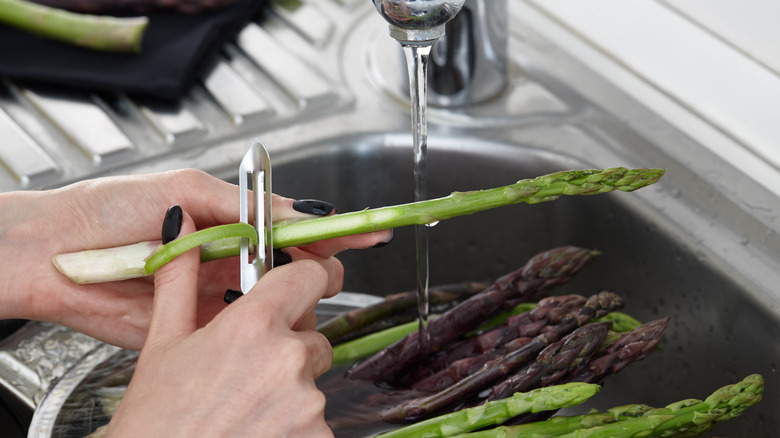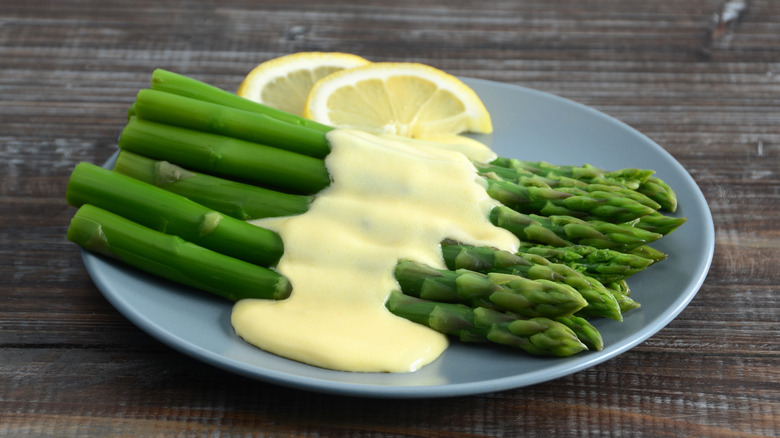How Julia Child Made Perfect Asparagus
You may have seen plenty of well-meaning cooks say you should prepare raw asparagus by snapping it in half, separating the tough and woody stem from the succulent tops. However, in the words of Julia Child, "That's a terribly wasteful way of cooking asparagus" (via YouTube). She points out that as long as you are buying it freshly-picked, nearly the whole asparagus stalk is completely edible.
The bottom end is indeed heartier than the rest of the plant, so on an episode of "The French Chef," Child instructed to peel the stalks with a paring knife, vegetable peeler, or even a Norwegian cheese knife. Cut off about a quarter inch off the bottom, and then carefully run the knife or peeler up towards the scaly top, tapering off about two inches before you reach the head. Keep peeling until the texture of the flesh changes from stringy to soft. This method also creates a uniform shape that helps the stalks cook more evenly.
Once peeled, Child arranged the asparagus into bunches and tied them at both the top and bottom with kitchen twine. She dropped the bunches into a big pot of well-salted boiling water and cooked them for about five minutes. When done, she simply lifted each bundle out by the strings, drained them, snipped the twine, and arranged the spears on a serving plate. The strings make it so that you don't squeeze the asparagus too much, which could make them bruised by your cooking utensils.
How to buy and store asparagus
Julia Child was also fanatical about the quality of the produce she cooked with — that is a huge part of making even simple dishes like this one taste extraordinary. To find a bunch of asparagus that Child would have approved of, you have to know what to look for.
Asparagus is actually the tender stalk of a flowering perennial plant. It grows into a spindly, fern-like bushy plant with red berries, and the scaly tops bloom into the seed pods. As a plant goes to seed, the texture toughens and the taste is not as desirable, so look for stalks that have tops with tight-fitting, overlapping scales. Once they start to form individual flower buds, the plant is probably too mature. Also, look for stalks that are vibrantly colored, straight, firm, and relatively even in size from butt to tip. Going for large pieces is better for Child's preferred method, since it makes them much easier to peel.
Good asparagus should look fresh and hydrated. If otherwise-attractive looking stalks seem a little dry, Child suggested cutting off just a bit of the bottoms, and placing them upright in a pot or bowl of water. Then, she covered the tops loosely in a plastic bag and stored it all in the refrigerator. Change the water regularly, and the asparagus should stay fresh for about four days using this strategy. And if you find asparagus already stored this way at the market, all the better.
How to serve Julia Child's perfect asparagus
When prepared with care, Julia Child said that asparagus can be eaten with just a bit of lemon and salt, which is perfectly delightful for a side dish, but there are many more tasty ways to serve this simple asparagus preparation. She also suggested plain butter, lemon butter, or drawn butter, that latter of which has just been melted and quickly clarified.
Hollandaise — one of the French mother sauces — is another classic and Julia Child-approved accompaniment. Child even took it a step further and made sauce maltaise for the asparagus on her show, which is just a basic hollandaise sauce recipe with the extra addition of orange juice and zest. If you are intimidated by this sometimes finicky sauce, there are plenty of tips and tricks to help you, like with Ree Drummond's blender hollandaise, but Child said, "I think you ought to get in the habit of not getting so scared of egg yolks and hollandaise" (via YouTube). Give it a try — Julia believes in you!
Otherwise, preparing asparagus this way is ideal for cooking for a crowd or meal prepping for the week. If you are going to stash the cooked asparagus in the fridge instead of serving it immediately, consider giving it an ice water dunk first, which helps to preserve the color and texture.



